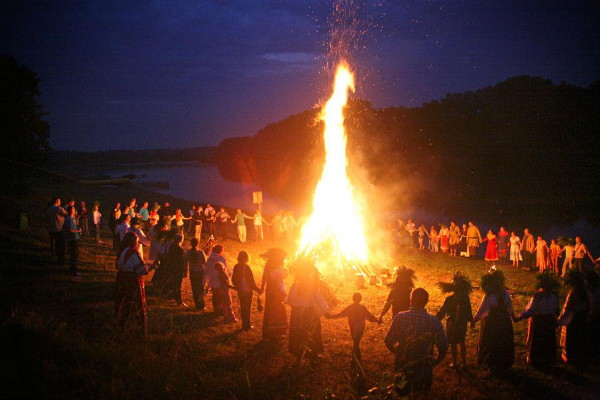Kupalo festival
Kupalo festival (also Kupailo, Ivan Kupalo). A Slavic celebration of ancient pagan origin marking the end of the summer solstice and the beginning of the harvest (midsummer). In the western Ukrainian Lemko region and Prešov region it was called Sobitka. In Christian times, the church tried to suppress the tradition, substituting it with the feast day of the Nativity of Saint John the Baptist (24 June), but it remained firmly part of folk ritual as the festival of Ivan (John, from Saint John) Kupalo.
Kupalo was believed to be the god of love and of the harvest and the personification of the earth's fertility. According to popular belief, ‘Kupalo eve’ (‘Ivan's eve’) was the only time of the year when the earth revealed its secrets and made ferns bloom to mark places where its treasures were buried, and the only time when trees spoke and even moved and when witches gathered. It was also the only time of the year when free love received popular sanction. On the eve unmarried young men and women gathered outside the village in the forest or near a stream or pond. There they built ‘Kupalo fires’—a relic of the pagan custom of bringing sacrifice—around which they performed ritual dances (see Khorovod) and sang ritual songs, often erotic. They leaped over the fires, bathed in the water (an act of purification), and played physical games with obviously sexual connotations. The fires were also used to burn herbs gathered in the previous year and various items of no further use, particularly those that had been blessed with holy water and could therefore not be discarded by normal means. The fires were never extinguished, but were always allowed to smolder out. On the eve female participants wore scented herbs and flowers to attract the males and adorned their hair with garlands of freshly cut flowers. Later they divined their fates according to what happened to the garlands which they had sent flowing on the water.
An integral part of the festivities was a supper of eggs, varenyky, and liquor. An anthropomorphic effigy of Kupalo or a decorated sapling representing him was burned, drowned, buried, or torn apart and scattered in the fields as a symbol of the impending decline in the earth's fertility. In some regions Kupalo was represented by a wheel laced with dry grasses or straw, which was set on fire and rolled down a hill as a symbol of the declining life-giving powers of the sun after the solstice. The representation of Kupalo was frequently identified with Kostrub, the pagan god of winter, or with Marena, the goddess of spring.
Magical properties were ascribed to the plants and herbs gathered on Kupalo eve. It was believed that such herbs could protect one from the evil forces of nature and even cure illnesses in humans and animals. Local priests seemingly sanctioned this belief by blessing the herbs in church on the day of the Nativity of Saint John the Baptist. On the morning of that day girls washed themselves with the dew that had fallen on Kupalo eve, which they collected in a bowl left outside overnight, and ran barefoot through the bedewed fields in the belief that doing so would accelerate their opportunity to get married. The sick would roll naked in the dewy meadows in the belief that this action would help them get well, and farmers would run their cattle through such meadows in the belief that this routine would prevent disease.
Written references to the festival date from the 11th century. Its origins are much earlier, however. On a 4th-century calendar pot found in the Middle Dnipro River region once inhabited by the Slavic Polianians, for example, the time of the festival was already marked by two crosses. The term ‘Kupalo’ was itself first mentioned in the Hypatian Chronicle under the year 1262. In medieval and early-modern church documents—eg, ‘The Sermon of Saint John Chrysostom’ and the ‘Epistle of Hegumen Pamphil’ of Pskov Monastery (1515)—there are fairly detailed descriptions of the lascivious festivities. Despite the efforts of the church and secular rulers—eg, Hetman Ivan Skoropadsky issued a decree in 1719 categorically forbidding it, and many similar decrees were later issued—the tradition proved too old and too well rooted to disappear. By the late 19th century most of the pagan beliefs connected with the Kupalo rituals had vanished, but the festival was still widely celebrated to mark the beginning of the harvest (see Harvest rituals). As a theme it has figured in the writings of Nikolai Gogol, Mykhailo Starytsky, Lesia Ukrainka, Olha Kobylianska, and Mykhailo Kotsiubynsky, in the music of Mykola Lysenko and Anatol Vakhnianyn, in the paintings of Olena Kulchytska, and in an early film by Danylo Sakhnenko.
In postwar Soviet Ukraine, efforts have been made to revive a Sovietized, politicized version of Kupalo rituals. In 1958 the Supreme Soviet of the Ukrainian SSR designated the last Sunday in June the ‘Day of Soviet Youth’ and recommended that it become a youth holiday throughout the USSR. Attempts at incorporating traditional rituals into the celebration of this day have not been widely accepted, however, because of the contrived nature of the Soviet Kupalo festival.
BIBLIOGRAPHY
Potebnia, A. O kupal’skikh ogniakh i srodnykh s nimi predstavleniiakh (Moscow 1867; Kharkiv 1914)
Ukraïnka, L. ‘Kupala na Volyni,’ Zhytie i slovo, 1 (Lviv 1894)
Dei, O. (ed). Ihry ta pisni (Kyiv 1963)
Shmaida, M. Sobitky (Prešov 1963)
Dei, O. (ed). Kupal’s’ki pisni (Kyiv 1970)
Sviata ta obriady Radians’koï Ukraïny (Kyiv 1971)
Mykola Mushynka

.jpg)